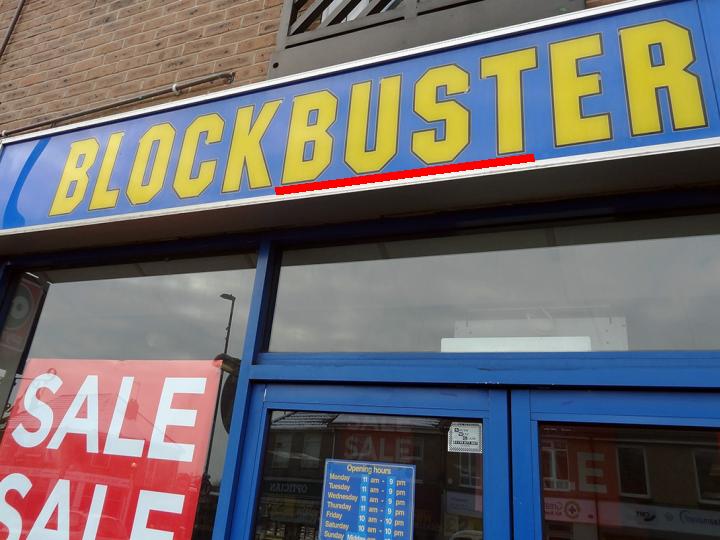 The Gap has been a fixture of UK High Streets for many years and has had both ups and downs. In a highly competitive market, it faces fierce rivals from other high street retailers and also from an increasingly important online presence. Same-shop sales for Gap fell in July by 7% and the brand is now finding itself in a tricky position.
The Gap has been a fixture of UK High Streets for many years and has had both ups and downs. In a highly competitive market, it faces fierce rivals from other high street retailers and also from an increasingly important online presence. Same-shop sales for Gap fell in July by 7% and the brand is now finding itself in a tricky position.
Although the Gap does sell products at a variety of prices, even sales growth in its most affordable line was not sufficient to offset declines elsewhere. It’s not just the UK where this decline is observed, with 175 Gap specialty shops in America being shut down over the next year. This will inevitably mean job losses. So why is Gap struggling so much, after being such a popular brand?
Its competitors are arguably offering a very similar product, but at a lower price. Consumers, being increasingly aware of prices and having many more options to make price comparisons, are perhaps using this information to make better choices. If they don’t believe that they are getting something extra from paying a slightly higher price at Gap, then they’d prefer to get the same thing elsewhere, from somewhere like Forever 21 or H&M. Some also suggest that the product itself is out of date and with the world of high fashion being such an important part of life for many people, an out-of-date product is bad news. That, together with consumers finding more and more things that they can spend their money on, beyond clothes has led to a tricky position for the Gap.
A key part of maintaining a presence on high streets has been sales and special offers – this has been a key element in keeping customers coming, but it is certainly not a long term strategy. Research analysts have been investigating some of the key aspects of the Gap and various comments have been made, including:
“Uniformity is no longer cool… The trick now is convincing your customer that they’re getting something unique.” (Simeon Siegel), Nomura Securities.
“Of top priority is delivering more consistent and compelling product collections.” Kari Shellhorn, Gap spokeswomen.
“Whether it’s colour or print or it’s pattern, the Gap brand hasn’t been kept up to date … Until they have their product right, I think we’ll continue to see them have promotions.” Dana Telsey, Telsey Advisory Group.
The future of Gap is certainly in the balance and with an increasingly competitive market when it comes to retail, an effective strategy to maintain and increase its market share will be essential.
Why Gap is in a tight squeeze BBC News, Gianna Palmer (20/8/15)
Gap Inc sees some potential for next year but Q2 2015 remains weak Forbes, Investing, Trefis Team (24/8/15)
Questions
- What sort of figure would you expect Gap’s clothes to have and why?
- Into which market structure would you place the retail industry? What does this tell us about how a company such as Gap can hope to make profits?
- If you were advising Gap, what strategies would you propose as a means of boosting revenue and cutting costs?
- The BBC News article states that the fortunes of Gap have been hurt by a strong US dollar. Why may this be the case?
 For years, the UK consumer organisation, Which?, has exposed misleading supermarket pricing practices. These include bogus price reductions, ‘cheaper’ multi-buys, smaller pack sizes and confusing special offers. Claiming that these practices are still continuing, Which? has made a super-complaint (available to designated consumer bodies) to the competition regulator, the Competition and Markets Authority (CMA).
For years, the UK consumer organisation, Which?, has exposed misleading supermarket pricing practices. These include bogus price reductions, ‘cheaper’ multi-buys, smaller pack sizes and confusing special offers. Claiming that these practices are still continuing, Which? has made a super-complaint (available to designated consumer bodies) to the competition regulator, the Competition and Markets Authority (CMA).
Commenting on this action, Which? executive director, Richard Lloyd said:
“Despite Which? repeatedly exposing misleading and confusing pricing tactics, and calling for voluntary change by the retailers, these dodgy offers remain on numerous supermarket shelves. Shoppers think they’re getting a bargain but in reality it’s impossible for any consumer to know if they’re genuinely getting a fair deal.
We’re saying enough is enough and using one of the most powerful legal weapons in our armoury to act on behalf of consumers by launching a super-complaint to the regulator. We want an end to misleading pricing tactics and for all retailers to use fair pricing that people can trust.”
The CMA will consider the issues raised under the super-complaint to establish whether any of them are significantly harming the interests of consumers. It will publish a response within 90 days from the receipt of the complaint on 21 April 2015. The possible outcomes include:
|
|
| • |
recommending the quality and accessibility of information for consumers is improved |
| • |
encouraging businesses in the market to self-regulate |
| • |
making recommendations to government to change the legislation or public policy |
| • |
taking competition or consumer enforcement action |
| • |
instigating a market investigation or market study |
| • |
a clean bill of health |
Some 40% of groceries are sold on promotion. Supermarkets are well aware that consumers love to get a bargain and use promotions to persuade consumers to buy things they might not otherwise have done.
 What is more, consumer rationality is bounded by the information and time available. People are often in a hurry when shopping; prices change frequently; people are often buying numerous low-value items; and they don’t know what competitors are charging. People may thus accept an offer as genuine and not spend time investigating whether it is so. Supermarkets know this and use all sorts of tactics to try to persuade people that they are indeed getting a bargain.
What is more, consumer rationality is bounded by the information and time available. People are often in a hurry when shopping; prices change frequently; people are often buying numerous low-value items; and they don’t know what competitors are charging. People may thus accept an offer as genuine and not spend time investigating whether it is so. Supermarkets know this and use all sorts of tactics to try to persuade people that they are indeed getting a bargain.
Videos
 Supermarkets Face Super-Complaint On Pricing Sky News (21/4/15)
Supermarkets Face Super-Complaint On Pricing Sky News (21/4/15)
 UK supermarkets face possible probe over pricing practices Reuters, Neil Maidment (21/4/15)
UK supermarkets face possible probe over pricing practices Reuters, Neil Maidment (21/4/15)
 Which? launches ‘super-complaint’ against supermarkets BBC News, Stephanie McGovern (21/4/15)
Which? launches ‘super-complaint’ against supermarkets BBC News, Stephanie McGovern (21/4/15)
Articles
UK supermarkets dupe shoppers out of hundreds of millions, says Which? The Guardian, Rebecca Smithers (21/4/15)
Supermarkets face inquiry into ‘rip-offs’ The Telegraph, Dan Hyde (21/4/15)
15 supermarket rip-offs that led to an inquiry The Telegraph, Dan Hyde (21/4/15)
What does Which?’s supermarket pricing complaint mean for you? The Guardian (21/4/15)
Supermarkets hit back over Which? report on pricing Financial Times (21/4/15)
Press release
Which? ‘super-complains’ about misleading supermarket pricing practices Which? (21/4/15)
CMA case page
Groceries pricing super-complaint Competition and Markets Authority (21/4/15)
Questions
- Give examples of supermarket offers that are misleading.
- Why are supermarkets able to ‘get away with’ misleading offers?
- How can behavioural economics help to explain consumer behaviour in supermarkets?
- Identify some other super-complaints have been made to the CMA or its predecessor, the Office of Fair Trading. What were the outcomes from the resulting investigations.
- What is meant by ‘heuristics’? How might supermarkets exploit consumers’ use of heuristics in their promotions?
 The typical UK high street is changing. Some analysts have been arguing for some time that high streets are dying, with shops unable to face the competition from large supermarkets and out-of-town malls. But it’s not all bad news for the high street: while some types of shop are disappearing, others are growing in number.
The typical UK high street is changing. Some analysts have been arguing for some time that high streets are dying, with shops unable to face the competition from large supermarkets and out-of-town malls. But it’s not all bad news for the high street: while some types of shop are disappearing, others are growing in number.
Part of the reason for this is the rise in online shopping; part is the longer-term effects of the recession. One consequence of this has been a shift in demand from large supermarkets (see the blog, Supermarket wars: a pricing race to the bottom). Many people are using local shops more, especially the deep discounters, but also the convenience stores of the big supermarket chains, such as Tesco Express and Sainsbury’s Local. Increasingly such stores are opening in shops and pubs that have closed down. As The Guardian article states:
The major supermarket chains are racing to open high street outlets as shoppers move away from the big weekly trek to out-of-town supermarkets to buying little, local and often.

Some types of shop are disappearing, such as video rental stores, photographic stores and travel agents. But other types of businesses are on the increase. In addition to convenience stores, these include cafés, coffee shops, bars, restaurants and takeaways; betting shops, gyms, hairdressers, phone shops and tattoo parlours. It seems that people are increasingly seeing their high streets as social places.
Then, reflecting the widening gap between rich and poor and the general desire of people to make their money go further, there has been a phenomenal rise in charity shops and discount stores, such as Poundland and Poundworld.

So what is the explanation? Part of it is a change in tastes and fashions, often reflecting changes in technology, such as the rise in the Internet, digital media, digital photography and smart phones. Part of it is a reflection of changes in incomes and income distribution. Part of it is a rise in highly competitive businesses, which challenge the previous incumbents.
But despite the health of some high streets, many others continue to struggle and the total number of high street stores across the UK is still declining.
What is clear is that the high street is likely to see many more changes. Some may die altogether, but others are likely to thrive if new businesses are sufficiently attracted to them or existing ones adapt to the changing market.
How the rise of tattoo parlours shows changing face of Britain’s high streets The Guardian, Zoe Wood and Sarah Butler (7/10/14)
The changing face of the British High Street: Tattoo parlours and convenience stores up, but video rental shops and travel agents down Mail Online, Dan Bloom (8/10/14)
High Street footfall struggles in August Fresh Business Thinking, Jonathan Davies (15/9/14)
Ghost town Britain: Internet shopping boom sees 16 high street stores close every day Mail Online, Sean Poulter (8/10/14)
Questions
- Which of the types of high street store are likely to have a high income elasticity of demand? How will this affect their future?
- What factors other than the types of shops and other businesses affect the viability of high streets?
- What advice would you give your local council if it was keen for high streets in its area to thrive?
- Why are many large superstores suffering a decline in sales? Are these causes likely to be temporary or long term?
- How are technological developments affecting high street sales?
- What significant changes in tastes/fashions are affecting the high street?
- Are you optimistic or pessimistic about the future of high streets? Explain.
 The Scottish debate revolved around a variety of issues and one of the key factors that added weight to the ‘No’ campaign was the idea of being British. But the concept of ‘Britishness’ is not just important to those who live here. It still appears to be a key signal of quality in foreign markets and it is something which foreign consumers are willing to pay a price for.
The Scottish debate revolved around a variety of issues and one of the key factors that added weight to the ‘No’ campaign was the idea of being British. But the concept of ‘Britishness’ is not just important to those who live here. It still appears to be a key signal of quality in foreign markets and it is something which foreign consumers are willing to pay a price for.
Barclays Corporate Banking has undertaken research into eight key export markets to determine the value of ‘Britain’. One of the key factors that boost demand for a product is quality and another is the idea of a brand. As quality improves and brands become more recognized, a product’s demand curve will begin to shift to the right, thus pushing up the market price. In other words, with higher quality and brand recognition, an individual’s willingness to pay rises. One brand that foreign consumers seem willing to pay a premium to purchase are those labelled ‘Made in Britain’.
The research indicates that 31% of customers in emerging markets have been prepared to and have purchased products that are from Britain, despite the higher price. Seeing the label ‘Made in Britain’ seems to send the signal of quality and this in turn creates a higher willingness to pay. Furthermore, this willingness to pay, while still good for Scottish, English and Welsh products, is higher for ‘British’ products, perhaps another indication of the truth behind the ‘Better together’ campaign.
The increase in willingness to pay between products with seemingly no country of origin and a British country of origin is 7% and this knowledge should give a confidence boost to the British export market. It should also indicate to exporters in Wales, Scotland and England that they are better to advertise as ‘Made in Britain’ than ‘Made in Wales, Scotland or England’. The expected boost from the 8 key emerging markets is around £2bn. The following articles consider the concept of ‘Brand Britain’.
Good news for exports as Brand Britain is revealed to be valuable concept Small Business, John Bromley (3/11/14)
Britain ‘best brand’ for Welsh exports, survey suggests BBC News (26/11/11)
Overseas consumers 64% more willing to pay premium for ‘Brand Britain’ Marketing Week, Sebastian Joseph (3/11/14)
Report flags up ‘British’ benefit The Courier, James Williamson (3/10/14)
Questions
- Using a diagram, illustrate the effect of a product’s being a well-known brand on its equilibrium price and quantity.
- Why is it that the relative willingness to pay a premium for British products is higher in developing countries than in developed countries?
- Using the concept of marginal utility theory, explain the impact of the ‘Made in Britain’ label.
- The BBC News article suggests, however, that some Welsh companies have not found the brand effect to be the case. What factors might explain this?
- To what extent are the concepts of consumer and producer surplus relevant here?
 Every year thousands of entrepreneurs will have another great idea that is sure to take off and bring in millions of customers. However, most of these great ideas will turn into another business failure. But, in the case of Dropbox, it is multiple business failures that eventually created a huge success, giving hope to millions of budding entrepreneurs.
Every year thousands of entrepreneurs will have another great idea that is sure to take off and bring in millions of customers. However, most of these great ideas will turn into another business failure. But, in the case of Dropbox, it is multiple business failures that eventually created a huge success, giving hope to millions of budding entrepreneurs.
With 300 million users, the file sharing ‘Dropbox’ is certainly a success, estimated at a value of $10bn. But it didn’t happen immediately and was preceded by a few failures. So, what is the secret to success in this case? The co-founder of Dropbox, Drew Houston, said that it is all about providing something that customers want. In the case of Dropbox, customers are crucial: the more people use it, the easier it becomes for others to use it too, as it allows file sharing on a much larger scale. Perhaps here we have a case of network externalities.
With Dropbox people would tell their friends about it and collaborate. So when you go into work and work on a project with colleagues you recruit them in essence to become Dropbox users because you’re all working on a project together.
No doubt there are many other examples of businesses that have proved a success after several failed attempts. Providing customers with what they want, at the time when they need it is clearly a key ingredient, but so, it appears, is business failure. The following article from BBC News considers the rise of Dropbox.
 Dropbox and the failures behind it BBC News, Richard Taylor (1/7/14)
Dropbox and the failures behind it BBC News, Richard Taylor (1/7/14)
Questions
- Customers are clearly crucial for any business to succeed. How can a new entrepreneur find out if there is a demand?
- Why was timing so important in the case of Dropbox?
- Given that customers can actually use Dropbox for free, how does this company make so much money?
- What are network externalities? Explain them in the context of Dropbox.
- Drew Houston says that ‘distribution’ is another key ingredient to success. What do you think is meant by this and how will it help create success?
The Gap has been a fixture of UK High Streets for many years and has had both ups and downs. In a highly competitive market, it faces fierce rivals from other high street retailers and also from an increasingly important online presence. Same-shop sales for Gap fell in July by 7% and the brand is now finding itself in a tricky position.







